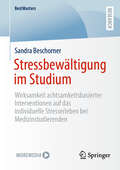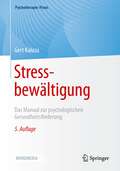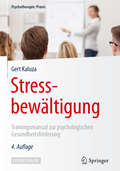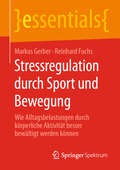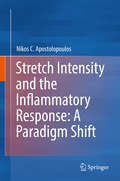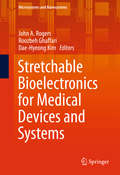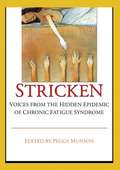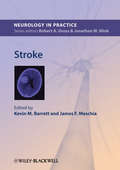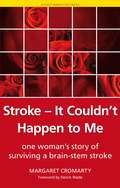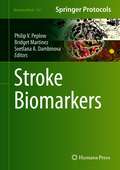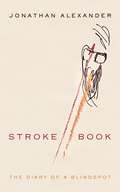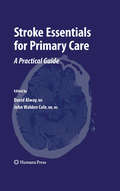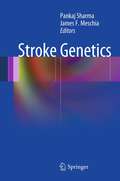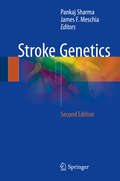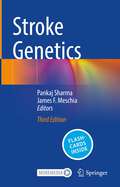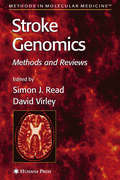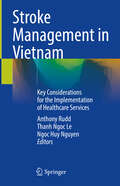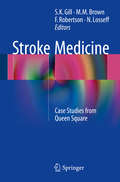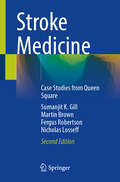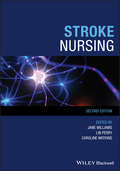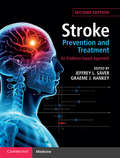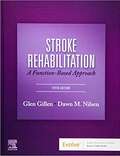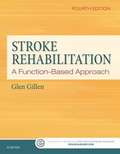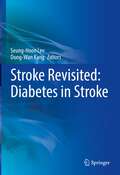- Table View
- List View
Stressbewältigung im Studium: Wirksamkeit achtsamkeitsbasierter Interventionen auf das individuelle Stresserleben bei Medizinstudierenden (BestMasters)
by Sandra BeschornerStress und psychische Belastungen sind unter Studierenden weit verbreitet, insbesondere bei Medizinstudierenden, die aufgrund der hohen Anforderungen ihres Studiums eine erhöhte Prävalenz klinisch relevanter psychischer Störungen aufweisen. Fehlende adäquate Stressbewältigungsstrategien können langfristig zu negativen gesundheitlichen und beruflichen Konsequenzen führen. In diesem Zusammenhang gewinnen achtsamkeitsbasierte Interventionen zunehmend an Bedeutung, da sie als wirksame Methode zur Stressreduktion gelten. Im Zentrum dieses Buches steht die Untersuchung der Wirksamkeit achtsamkeitsbasierter Interventionen auf das individuelle Stresserleben von Medizinstudierenden. Besonderes Interesse gilt der Frage, inwiefern bestimmte Interventions-Rahmenbedingungen die Wirksamkeit sowie die Teilnahmebereitschaft beeinflussen.
Stressbewältigung: Das Manual zur psychologischen Gesundheitsförderung (Psychotherapie: Praxis)
by Gert KaluzaMit diesem Manual werden Sie fit für die Durchführung des psychologischen Gesundheitsförderungsprogramms: Gelassen und sicher im Stress. Es wird seit über 25 Jahren erfolgreich eingesetzt und von den gesetzlichen Krankenkassen als geprüfte Präventionsmaßnahme gefördert. In Teil I finden Sie Hintergrundwissen aus der Stressforschung: kompakt, fundiert und verständlich. Teil II enthält die Trainingsbausteine: (1) Entspannungstraining: entspannen und loslassen. (2) Mentaltraining: förderliche Denkweisen und Einstellungen entwickeln. (3) Problemlösetraining: Stresssituationen wahrnehmen, annehmen und verändern. (4) Genusstraining: erholen und genießen. (5) Ergänzungsmodule zu Stressbewältigung durch Sport und Bewegung, Pflege des sozialen Netzes, Zielklärung, gesunden Umgang mit der Zeit und der 4xA-Strategie für den Akutfall. Aus dem Inhalt: Didaktische Hinweise für eine kompetente Durchführung des Trainings – abwechslungsreiche Gestaltung durch viele praktisch erprobte Übungen – Teilnehmerunterlagen, die informieren und motivieren – alle Trainingsmaterialien stehen zum Ausdrucken online zur Verfügung. Der Autor: Prof. Dr. Gert Kaluza ist psychologischer Psychotherapeut und als Trainer, Coach und Autor im Bereich der individuellen und betrieblichen Gesundheitsförderung tätig. Nach 20jähriger Tätigkeit an Universitäten gründete er 2002 sein eigenes Fortbildungs- und Trainingsinstitut, das GKM-Institut für Gesundheitspsychologie, das er bis 2022 selbst leitete.
Stressbewältigung: Trainingsmanual zur psychologischen Gesundheitsförderung (Psychotherapie: Praxis)
by Gert KaluzaMit diesem Kursleiter-Manual werden Sie fit für die Durchführung des psychologischen Gesundheitsförderungsprogramms "Gelassen und sicher im Stress". Es wird seit über 20 Jahren erfolgreich eingesetzt und von den gesetzlichen Krankenkassen als geprüfte Präventionsmaßnahme gefördert. In Teil I finden Sie Hintergrundwissen aus der Stressforschung: kompakt, fundiert und verständlich. Teil II enthält Trainingsbausteine in 4 Trainings- und 5 Ergänzungsmodulen: (1) Entspannungstraining: entspannen und loslassen. (2) Mentaltraining: förderliche Denkweisen und Einstellungen entwickeln. (3) Problemlösetraining: Stresssituationen wahrnehmen, annehmen und verändern. (4) Genusstraining: erholen und genießen. (5) Ergänzungsmodule zu Stressbewältigung durch Sport und Bewegung, Pflege des sozialen Netzes, Zielklärung, gesunden Umgang mit der Zeit und der 4xA-Strategie für den Akutfall.Aus dem Inhalt: Didaktische Hinweise für eine kompetente Durchführung des Trainings – abwechslungsreiche Gestaltung durch viele Übungen – Teilnehmerunterlagen, die informieren und motivieren – alle Trainingsmaterialien im Buch stehen zum Ausdrucken für Teilnehmer online zur Verfügung.Der Autor: Prof. Dr. Gert Kaluza ist psychologischer Psychotherapeut und als Trainer, Coach und Autor im Bereich der individuellen und betrieblichen Gesundheitsförderung tätig. Nach über 20jähriger Tätigkeit an Universitäten gründete er 2002 sein eigenes Fortbildungs- und Trainingsinstitut, das GKM-Institut für Gesundheitspsychologie.
Stressregulation durch Sport und Bewegung: Wie Alltagsbelastungen durch körperliche Aktivität besser bewältigt werden können (essentials)
by Reinhard Fuchs Markus GerberDie Frage, wie Bewegung und Sport dazu beitragen können, mit Stress und Belastungen im Alltag gesundheitsschonend umzugehen, hat für viele Menschen hohe subjektive Relevanz. In diesem essential stellen Markus Gerber und Reinhard Fuchs die gesundheitsrelevanten Aspekte von Bewegung und Sport in kompakter Form dar. Die Autoren geben einen Überblick darüber, was zu diesem Thema bereits bekannt ist, welche Erwartungen an den Sport realistischerweise geknüpft werden dürfen und woran im Speziellen gedacht werden sollte, wenn man Bewegung und Sport als Mittel zur Stressbewältigung vermitteln bzw. nutzen möchte.
Stretch Intensity and the Inflammatory Response: A Paradigm Shift
by Nikos C. ApostolopoulosIn this manuscript, practitioners and students who are concerned with sports and rehabilitation medicine, kinesiology, as well as coaches and athletes, are introduced to numerous concepts, including mechanotransduction, inflammation, pro- and anti-inflammatory cytokines, calpains, the extracellular matrix, neutrophils and macrophages, and their relevance to stretching, particularly stretching intensity. Although the quantitative parameters of training, duration, and frequency are important, it is the qualitative criterion of intensity (“how much”) that the author suggests is ultimately of greater concern. Intensity, the rate and magnitude of force, may be responsible for the proper recovery, regeneration, and adaptation of the musculoskeletal tissues from training, competition, or rehabilitation from injuries. Research suggests that too much force results in the stimulation of an inflammatory response, one associated with a biochemical feedback emerging from a mechanical stimulus. The intent of this manuscript is twofold: to initiate the discussion of the importance of stretching intensity with regard to proper recovery, regeneration, and adaptation, and to suggest that researchers need to explore its potential role in addressing numerous inflammatory (RA) and non-inflammatory (OA, recurrent tendinitis etc.) musculoskeletal conditions as well.
Stretchable Bioelectronics for Medical Devices and Systems
by John A. Rogers Roozbeh Ghaffari Dae-Hyeong KimThis book highlights recent advances in soft and stretchable biointegrated electronics. A renowned group of authors address key ideas in the materials, processes, mechanics, and devices of soft and stretchable electronics; the wearable electronics systems; and bioinspired and implantable biomedical electronics. Among the topics discussed are liquid metals, stretchable and flexible energy sources, skin-like devices, in vitro neural recording, and more. Special focus is given to recent advances in extremely soft and stretchable bio-inspired electronics with real-world clinical studies that validate the technology. Foundational theoretical and experimental aspects are also covered in relation to the design and application of these biointegrated electronics systems. This is an ideal book for researchers, engineers, and industry professionals involved in developing healthcare devices, medical tools and related instruments relevant to various clinical practices.
Stricken: Voices from the Hidden Epidemic of Chronic Fatigue Syndrome
by Peggy MunsonDevelop a better understanding of what CFS/CFIDS sufferers are going through!In the 1980s, a strange emerging epidemic baffled doctors in Incline Village, Nevada. Dismissed by the media as “The Yuppie Flu,” Chronic Fatigue Immune Dysfunction Syndrome (CFIDS) turned out to be neither a faddish disease of the wealthy nor a passing trend, but rather a growing worldwide epidemic of devastating proportions.In the voices of a South African journalist, a former marathon runner, a teenage girl, a public health activist living on the edge of race and gender, a cancer patient neglected by doctors because of disdain for her chronic illness, and a theologian relearning the art of spiritual empathy, the people who share their stories in Stricken: Voices from the Hidden Epidemic of Chronic Fatigue Syndrome defy cultural stereotypes and explore the complex social and political dynamics of this hidden epidemic. Through their distinct points of view, we feel the grief and hope of those stricken with CFIDS and learn of the complex nature of this misunderstood disorder. These are compelling stories about a quiet and baffling epidemic. The first American anthology to contain stories from a diverse range of people with CFIDS, Stricken offers an intimate look at the political and social issues surrounding CFIDS, as told by those who are living through this ordeal. Stricken addresses several issues, such as: why some doctors still do not believe CFIDS is real how the disease is mocked in the media myths about this illness the personal fight for medical or public recognition the skepticism and hope that is felt by the ever-growing number of CFIDS sufferers Stricken confronts fascinating CFIDS issues such as the Kevorkian suicides, accusations of Munchausen Syndrome By Proxy, Gulf War Syndrome, the role of storytelling in a memory-impaired patient movement, and the feasibility of mass activism in a disabled population. With contributions from Pulitzer-prize nominated writer Susan Griffin, renowned health writer and radio host Gary Null, well-known feminist activist Joan Nestle, and award-winning poet and essayist Floyd Skloot, Stricken is an eloquent testament to the heroism, defiance, and diversity of the CFIDS community.
Stripe Rust
by Xianming Chen Zhensheng KangThis book comprehensively introduces stripe rust disease, its development and its integral control. Covering the biology, genetics, genome, and functional genomics of the pathogen, it also discusses host and non-host resistance, their interactions and the epidemiology of the disease. It is intended for scientists, postgraduates and undergraduate studying stripe rust, plant pathology, crop breeding, crop protection and agricultural science, but is also a valuable reference book for consultants and administrators in agricultural businesses and education.
Stroke
by James F. Meschia Kevin M. BarrettThis book considers various topics regarding stroke, including bedside evaluation of the acute stroke patient; neurovascular imaging of the acute stroke patient; treatment of acute ischemic stroke; treatment of hemorrhagic stroke; prevention and management of post-stroke complications; diagnosis of stroke mechanism and secondary stroke prevention; post-stroke recovery; and considerations for very elderly and severely affected stroke patients. Essential reading for neurologists and cardiologists.
Stroke - it Couldn't Happen to Me: One Woman's Story of Surviving a Brain-Stem Stroke
by Shoaib Siddiqui Margaret CromartyMargaret Cromarty was a nurse who suffered a catastrophic stroke aged just 43, which left her with Locked-In Syndrome. Still paralysed even now, with the aid of an on-screen keyboard she has written this unflinching account of her treatment. It describes the frustrations of being fully aware but ignored as a person by carers unable to communicate effectively, and the painfully slow steps towards rehabilitation.It contains vital lessons for health professionals caring for victims of stroke, and for families and friends of patients. 'I learned later that the doctors expected that I would die. They made a poor attempt at concealing this expectation. They discussed me over me. I was dismayed at the negative vibes they exuded each time they came to see me. I felt that they had written me off already. Of course they can have had little idea of how their behaviour affected me. I just lay there, seemingly unresponsive, just existing, unable to enlighten them as to what was going on inside my head.' - Margaret Cromarty.
Stroke Biomarkers (Neuromethods #147)
by Philip V. Peplow Bridget Martinez Svetlana A. DambinovaThis volume presents the latest data on recent achievements in new and emerging technologies for stroke biomarkers and innovations in stroke assessment. The topics discussed in this book explore the role of upcoming biomarkers in different types of stroke, and explores techniques that will allow researchers to be more effective when approaching clinical management and patient care. In Neuromethods series style, chapters include the kind of detail and key advice from the specialists needed to ensure successful results in the laboratory.Cutting-edge and comprehensive, Stroke Biomarkers is a valuable resource for both experimental and clinical scientists interested in expanding their knowledge in the field of stroke research.
Stroke Book: The Diary of a Blindspot
by Jonathan AlexanderAn archive of personal trauma that addresses how a culture still toxic to queer people can reshape a bodyIn the summer of 2019, Jonathan Alexander had a minor stroke, what his doctors called an “eye stroke.” A small bit of cholesterol came loose from a vein in his neck and instead of shooting into his brain and causing damage, it lodged itself in a branch artery of his retina, resulting in a permanent blindspot in his right eye. In Stroke Book, Alexander recounts both the immediate aftermath of his health crisis, which marked deeper health concerns, as well as his experiences as a queer person subject to medical intervention.A pressure that the queer ill contend with is feeling at fault for their condition, of having somehow chosen illness as punishment for their queerness, however subconsciously. Queer people often experience psychic and somatic pressures that not only decrease their overall quality of life but can also lead to shorter lifespans. Emerging out of a medical emergency and a need to think and feel that crisis through the author’s sexuality, changing sense of dis/ability, and experience of time, Stroke Book invites readers on a personal journey of facing a health crisis while trying to understand how one’s sexual identity affects and is affected by that crisis. Pieceing and stitching together his experience in a queered diary form, Alexander’s lyrical prose documents his ongoing, unfolding experience in the aftermath of the stroke. Through the fracturing of his text, which almost mirrors his fractured sight post-stroke, the author grapples with his shifted experience of time, weaving in and out, while he tracks the aftermath of what he comes to call his “incident” and meditates on how a history of homophobic encounters can manifest in embodied forms.The book situates itself within a larger queer tradition of writing—first, about the body, then about the body unbecoming, and then, yet further, about the body ongoing, even in the shadow of death. Stroke Book also documents the complexities of critique and imagination while holding open a space for dreaming, pleasure, intimacy, and the unexpected.
Stroke Essentials for Primary Care
by John Walden Cole David AlwayStroke Essentials for Primary Care: A Practical Guide is a must-have resource, offering the essential, practical knowledge required to evaluate and treat stroke patients. While an indispensable guide for primary care clinicians, including family practitioners and medical internists who often assume the care of stroke patients without the aid of a neurologist (primarily in underserved areas), the information contained herein is also an invaluable resource to all physicians in training, especially residents and fellows in neurology, cardiology, and surgery, among others. Stroke Essentials for Primary Care: A Practical Guide provides the latest diagnostic and treatment information that allows for greater clinical confidence. Designed to allow easy access to essential information, most chapters include a quick summary of their content and conclusions. Chapters review information on such topics as distinguishing features of presentation, rapid determination of stroke type, prevention strategies, long-term complications, and special topics that may apply to specific populations. Targeted and easy to read, Stroke Essentials for Primary Care: A Practical Guide is an essential resource for all practitioners in primary care medicine and specialty physicians in training.
Stroke Genetics
by James F Meschia Pankaj SharmaOver the last decade there has been a substantial increase in our understanding of the genetic basis of common disorders such as stroke. Stroke Genetics is designed to give the reader an overall understanding of the genetics of complex diseases by using stroke as a paradigm. The reader will gain a comprehensive understanding of cerebrovascular genetics including the epidemiological evidence for the genetic basis of ischemic and hemorrhagic stroke, knowledge of its molecular basis from association, linkage and recent genome-wide studies, and also monogenic disorders. Finally, the legal and ethical complexities in dealing with these issues are discussed. Stroke Genetics benefits from the contribution of renowned experts from throughout the world who have been intimately involved in unraveling the genetic etiology of stroke. Stroke Genetics is a valuable resource for neurologists, stroke physicians, hypertension specialists, internists, clinical pharmacologists and those in training, as well as researchers in the field of disease genetics.
Stroke Genetics
by Pankaj Sharma James F. MeschiaOver the last decade there has been a substantial increase in our understanding of the genetic basis of common disorders such as stroke. Stroke Genetics is designed to give the reader an overall understanding of the genetics of complex diseases by using stroke as a paradigm. The reader will gain a comprehensive understanding of cerebrovascular genetics including the epidemiological evidence for the genetic basis of ischemic and hemorrhagic stroke, knowledge of its molecular basis from association, linkage and recent genome-wide studies, and also monogenic disorders. Finally, the legal and ethical complexities in dealing with these issues are discussed. Stroke Genetics benefits from the contribution of renowned experts from throughout the world who have been intimately involved in unraveling the genetic etiology of stroke. Stroke Genetics is a valuable resource for neurologists, stroke physicians, hypertension specialists, internists, clinical pharmacologists and those in training, as well as researchers in the field of disease genetics.
Stroke Genetics
by Pankaj Sharma James F. MeschiaThis revised, expanded third edition updates the reader on this fast moving field as well providing an overall understanding of the genetics of complex diseases by using stroke as a paradigm. The reader will gain a comprehensive understanding of cerebrovascular genetics including the epidemiological evidence for the genetic basis of ischemic and hemorrhagic stroke, knowledge of its molecular basis from association, linkage and recent genome-wide studies, and also monogenic disorders. Finally, the legal and ethical complexities in dealing with these issues are discussed.Stroke Genetics is a valuable resource for neurologists, stroke physicians, hypertension specialists, internists, clinical pharmacologists and those in training, as well as researchers in the field of disease genetics. Each chapter now contains teaching/training MCQs to help with retention of information learnt from each chapter and this will be of considerable use to those training or about to the examined inthe field of inherited stroke.Additional questions via app: Download the Springer Nature Flashcards app for free and use exclusive additional material to test your knowledge.
Stroke Genomics
by Simon J. Read David VirleyLeading experts explore the pragmatic application of the tools of genomic and molecular biology research to the treatment of stroke. Providing the reader with cutting-edge reviews of clinical and preclinical genomics, the authors relate changes in gene expression to physiological endpoints-such as functional imaging paradigms-to produce a more holistic approach in which molecular biology goes hand-in-hand with stroke pathophysiology. Topics of special interest include stem cell transplantation, gene therapy, clinical gene/gene interaction studies, and cytokine drug discovery. Readily reproducible techniques are provided, along with ancillary methods (imaging, animal models, human genetic study design, and transgenic animal production) that can be effectively applied to gene discovery. The book shows how to successfully design, execute, and interpret preclinical and clinical molecular biological studies of stroke, work that will greatly advance its understanding, as well as rapid development of the next generation of stroke therapeutics.
Stroke Management in Vietnam: Key Considerations for the Implementation of Healthcare Services
by Anthony Rudd Thanh Ngoc Le Ngoc Huy NguyenThis book covers the epidemiology, diagnosis, acute treatment, and rehabilitation of stroke, the most common cause of death and disability in Vietnam. Stroke survivors are frequently left severely affected, including symptoms such as paralysis, difficulty swallowing/talking, balance problems, dizziness, and memory loss. The book contains chapters on prevention and treatment, current research, health economics, traditional medicine, optimal organization of care, pharmacology, and much more. Because stroke survivors have long-term disabilities, understanding the training requirements for stroke staff is critical. ‘Stroke in Vietnam’ is written by leading stroke professionals from Vietnam and internationally, and it will be helpful to all health professionals, including nurses, therapists, doctors, and medical students in Vietnam, Southeast Asia, and worldwide.
Stroke Medicine
by S. K. Gill M. M. Brown F. Robertson N. LosseffThis collection of case studies is authored by a group of internationally recognised experts in the field of cerebrovascular disease. The cases are carefully selected to provide an insight into the different kinds of stroke syndromes from the common through to more rare presentations of cerebrovascular pathology. Each case is worked through with a discussion on presentation, clinical features, examination, radiological findings and management. Finally, learning points are highlighted to help the reader focus on the key points of the case study. Stroke Medicine: Case Studies from Queen Square is aimed at medical students and doctors in all stages of training from foundation years through to consultancy.
Stroke Medicine: Case Studies from Queen Square
by Martin Brown Fergus Robertson Sumanjit K. Gill Nicholas LosseffThis thoroughly revised second edition features a collection of case studies of cerebrovascular disease. The cases are carefully selected to provide an insight into the different kinds of stroke syndromes from the common through to more rare presentations of cerebrovascular pathology. New topics covered include mechanical thrombectomy and advanced imaging techniques which have been developed and brought into clinical practice over the past five years. A range of diagnostically challenging cases are also discussed. Each case is worked through with a discussion on presentation, clinical features, examination, radiological findings and management. Key clinical and radiological learning points are highlighted assisting the reader to quickly extrapolate the most important information covered in each chapter. Stroke Medicine: Case Studies from Queen Square is a detailed case-based resource based-upon the experiences of leading figures in the field. Therefore, itis ideal for use by both medical students and physicians in all stages of training from foundation years through to consultancy who wish to learn more about this subject.
Stroke Nursing
by Jane Williams Caroline Watkins Lin PerryNurses are in contact with people at risk of, and following stroke, at every stage of their journey and in all settings. The market-leading guide for stroke nursing has been fully updated to reflect advances in clinical management of stroke, and provides a practical, evidenced-based, text to facilitate the provision of optimal stroke care during the primary prevention and acute phases. It also includes consideration of rehabilitation, recovery and discharge planning, which are integral to acute stroke management and the impact on the experience of life after stroke of individuals and their families. This essential text provides a greater focus on clinical application in practice, as well as an additional new chapter focused on the knowledge and skills required by nurses. • Explores UK and international perspectives on stroke management, and how it underpins management recommendations. • Structured to follow the acute stroke pathway experienced by patients. • Additional case studies and practice examples. • Explicitly links knowledge and skills to clinical practice required by clinicians in the provision of contemporary stroke care. • Authored by experienced and expert clinicians and leaders in the field of nursing practice, research and education.
Stroke Prevention and Treatment: An Evidence-based Approach
by Graeme J. Hankey Jeffrey L. SaverStroke is the second leading cause of death and a leading cause of disability worldwide. This invaluable reference provides clinicians caring for stroke patients with ready access to the optimal evidence for best practice in stroke prevention, acute stroke treatment, and stroke recovery. Now an edited volume, the editors and authors, many of whom are members of the Cochrane Stroke Review Group, describe all available medical, endovascular, and surgical treatments; the rationale for using them; and the strength of the evidence for their safety and effectiveness. New chapters cover key, rapidly advancing therapeutic topics, including prehospital stroke care and regionalized stroke systems, endovascular reperfusion therapy, and electrical and magnetic brain stimulation to enhance recovery. This is an essential resource for clinicians translating into practice the many dramatic advances that have been made in the treatment and prevention of stroke, and suggesting the most appropriate interventions.
Stroke Rehabilitation: A Function-based Approach
by Glen Gillen Dawn M. NilsenLearn to confidently manage the growing number of stroke rehabilitation clients with Gillen’s Stroke Rehabilitation: A Function-Based Approach, 5th Edition. Using a holistic and multidisciplinary approach, this unique text remains the only comprehensive, evidence-based stroke rehabilitation resource for occupational therapists. <p><p>This new fifth edition has been extensively updated to include the research, trends, and best practices in the field. As with previous editions, this comprehensive reference uses an application-based method that integrates background medical information, samples of functionally based evaluations, and current treatment techniques and intervention strategies.
Stroke Rehabilitation: A Function-based Approach (Fourth Edition)
by Glen GillenThe fourth edition of Stroke Rehabilitation: A Function-Based Approach continues to strive to be the most up-to-date text on this topic, incorporating state-of-the-art and evidence-based tools and techniques to maximize function and quality of life for those living with stroke. This edition's contributors include expert clinicians, researchers, and scientists from across the globe. Contributors are experts in various disciplines, including neurology, occupational therapy, physiatry, physical therapy, psychology, and speech and language pathology.
Stroke Revisited: Diabetes in Stroke (Stroke Revisited)
by Seung-Hoon Lee Dong-Wan KangThis book presents state of the art knowledge on diabetes in stroke, covering both basic and clinical aspects in detail. The focus is in particular on two major areas: general knowledge of diabetes and diabetes from a stroke neurologist’s perspective. Readers will find up-to-date information on glucose metabolism, the pathophysiology of diabetes, the clinical significance of diabetes in stroke, the differential influence of diabetes on stroke mechanisms, principles of diabetes care, advances in treatment options, and clinical practice in the real world. The individual components of pathophysiology, management, and key issues are fully addressed with the aid of complementary illustrations that facilitate understanding of practical aspects and enable the reader to retrieve fundamental information quickly. The book is timely in bringing together within one volume the most important current knowledge on diabetes in stroke. It will be invaluable for stroke physicians, epidemiologists, and students seeking to acquire up-to-date knowledge.
